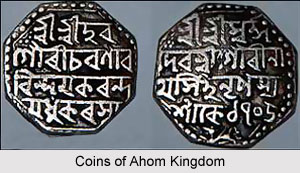 Suhungmung was the king of Ahom dynasty who reigned over the kingdom from 1497 to 1539 AD. The reign of Suhungmung was very significant in the history of medieval Assam. He brought about new changes in the kingdom, freeing it from the clutches of old administration, and set up a multi ethnic society. His reign also marked great expansions of Ahom kingdom. Invasions of Muslim rulers and Turbak Khan were also successfully prevented by Suhungmung. Collapse of Khen dynasty also took place in this period whereas the Koch dynasty captured the Kamata kingdom. Tonkham, the general of Suhungmung, chased the Muslim invaders up to the western border of Kamarupa kingdom, towards Karatoya River. This was the farthest venture of the Ahoms in their entire history. Suhungmung was also the first king of the dynasty who adopted a Hindu title, Swarganarayana. Suhungmung had made Bakata along the bank of Dihing River, the capital of the kingdom for which he was also called as Dihingia Raja.
Suhungmung was the king of Ahom dynasty who reigned over the kingdom from 1497 to 1539 AD. The reign of Suhungmung was very significant in the history of medieval Assam. He brought about new changes in the kingdom, freeing it from the clutches of old administration, and set up a multi ethnic society. His reign also marked great expansions of Ahom kingdom. Invasions of Muslim rulers and Turbak Khan were also successfully prevented by Suhungmung. Collapse of Khen dynasty also took place in this period whereas the Koch dynasty captured the Kamata kingdom. Tonkham, the general of Suhungmung, chased the Muslim invaders up to the western border of Kamarupa kingdom, towards Karatoya River. This was the farthest venture of the Ahoms in their entire history. Suhungmung was also the first king of the dynasty who adopted a Hindu title, Swarganarayana. Suhungmung had made Bakata along the bank of Dihing River, the capital of the kingdom for which he was also called as Dihingia Raja.
Expansion of Ahom Kingdom
During the rule of Suhungmung, Ahom kingdom expanded its boundaries to great extents. In 1504, he suppressed the revolt of Aitonia Nagas following which they accepted the over lordship of Ahoms. He also captured the Habung region. However his most important annexation was the Sutiya kingdom.
Expedition against Sutiya Kingdom
In 1513, Suhungmung got involved in a conflict with Sutiya king after the annexation of Namdang and Mungkhrang. Dhir Narayana was the Sutiya king at that time. When the new fort of Mungkhrang was captured in 1520, the Sutiyas counterattacked the Ahoms which led to a battle. The battle was won by the Ahoms who ultimately owned the fort and expanded the kingdom up to the Tiphao River bank. A new fort was established there which was again attacked by Sutiyas. Sutiyas were once again defeated in an expedition led by Suhungmung himself. The Sutiyas were further attacked and finally the king and the prince of the kingdom died in the battle. Sutiya royal heirlooms were then possessed by Suhungmung and in the newly captured region an office was established for Sadiakhowa Gohain. This was the first significant expansion of Ahom kingdom during the rule of Suhungmung.
Expedition against Kachari Kingdom
Expeditions against Kachari kingdom were started in 1526 by Suhungmung. In 1531 the ruler of Kachari kingdom, Khunkhara, sent his army under the commander ship of his brother Detcha for driving away the Ahoms from Marangi. In the battle, the Kacharis were gravely defeated. Kacharis were then chased up to Dimapur, their capital, and Khunkhara fled away. Following this, Detsung, a Kachari prince was made the king of the Kachari kingdom. After a few years, Detsung, also revolted against the Ahoms but was attacked till Jangmarang and killed. Dimapur was then permanently abandoned by the Kacharis and they set up their new capital at Maibong.
Defence against Muslim Invasion
In 1527 the Muslim rulers invaded the Ahom Kingdom but were gravely defeated. The second attempt to invade the kingdom was made after a few years in which they marched up to the Brahmaputra. But the invaders were once again defeated and Barpatra Gohain killed the commander named Bit Malik along with the possession of guns and cannons. In April 1532 a Gaur commander, Turbak, marched against the Ahom kingdom with a large army. Suklenmung, the son of Suhungmung initially defended their kingdom at Singri. Suklenmung was however defeated and injured in the battle after which the Ahoms backed off to Sala. At Sala, the Ahoms were again attacked and after a number of expeditions, the Ahoms recorded their first victory in March 1533. Their victory caused great losses to the army of Turbak. Finally the Ahoms defeated the Muslim invaders in the following several battles. The final battle took place near Bharali River in which Turbak was executed and his army was chased up to Karatoya River which is presently in north Bengal. The soldiers who were arrested later constituted a major Muslim population of the kingdom. They were known as Garia owing to their Gaur origin. This population later emerged as renowned brass craftsmen of the region.
Suhungmung was stabbed to death by one of his servants, Ratiman, while he was asleep. According to some historians, Suklenmung, the son of Suhungmung was also involved in the conspiracy of his assassination. There were four sons of Suhungmung among which Suklenmung was the eldest who succeeded his throne. Suleng was his second son who was given the position of Charing Raja. Suteng was the third son who was known as the Namrupiya Raja. Sukhring, his fourth son, did not get any estate of his own.



















